the Pythagorean Order of Death
dedicated to restoring Atlantean Democracy
Regional::Blue:Isocahedron::EM:Mars::Aries:Scorpio::Nefesh
Open to the "Argentum Astrum" or outer three degrees of co-masonry (OES)
----------------------------------------------------------------------------------------
----------------------------------------------------------------------------------------
 these are the reverse sides of the tablets of the ancient "law," the right understanding and meaning of which have long since been forgotten.
these are the reverse sides of the tablets of the ancient "law," the right understanding and meaning of which have long since been forgotten.
----------------------------------------------------------------------------------------
:: the "name of the "rose" ::
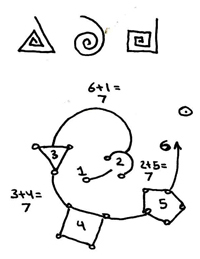

This is the "Rose" that "grew" over the "ruins."
----------------------------------------------------------------------------------------
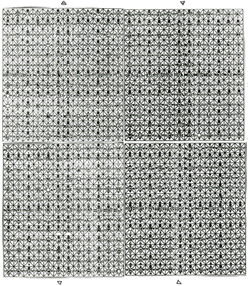 the four cardinal direction, elemental "Watch Towers" of the Enochian system.
the four cardinal direction, elemental "Watch Towers" of the Enochian system.
----------------------------------------------------------------------------------------
----------------------------------------------------------------------------------------
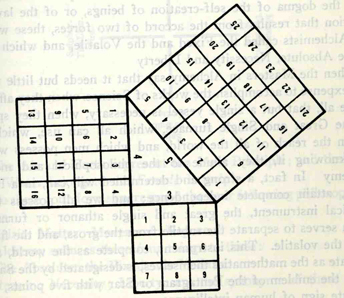 these diagrams will show you how to fold the "kamea" #-squares around a Pythagorean spiral.
these diagrams will show you how to fold the "kamea" #-squares around a Pythagorean spiral.
----------------------------------------------------------------------------------------
----------------------------------------------------------------------------------------
----------------------------------------------------------------------------------------
-
Comment by Jonathan Barlow Gee on March 29, 2012 at 10:39am
-
The Prieurie De Zion, or Priory (Catholic Order) of Zion, is much more real historically, and much more commonly known, as the Knights Templar.
The Knights Templar were founded by nine monastic knights, and these nine knights comprised the Catholic Order of Citeaux, known for its philosophy of "zionism."
These nine knights were:
1) Hugh de Payens, Legate of the Holy See, and Archbishop of Lyons, who gave holy sanction to the formation of the Order of six original members.
2) St. Robert, son of the noble Thierry and Ermengarde of Champagne, Abbot of Molesme, a monastery dependent on Cluny. Appalled by the laxity into which the Order of Cluny had fallen, he endeavoured to effect reforms in the monasteries of Saint-Pierre-de-la-Celle, Saint-Michel of Tonnerre, and finally in that of Molesme.
3) Raynald, Viscount of Beaune, ceded to the number of twenty-one the company retired to the solitude of Cîteaux (in the Diocese of Chalons).
4) Gauthier, bishop of the diocese.
5) the prior, Alberic, was elected to replace St. Robert at Cîteaux. St. Alberic died in 1109.
6 & 7) John and Ilbode, two monks sent as delegates to Pascal II (who had just succeeded Urban II) to beg him to take the church of Cîteaux under the protection of the Apostolic See.
8) Pascal II declared that he took under his immediate protection the abbey and the religious, of Cîteaux, saving their allegiance to the Church of Chalons.
9) Stephen Harding, an Englishman by birth, well versed in sacred and profane science, who had been one of the first promoters of the project to leave Molesme.
-
Comment by Jonathan Barlow Gee on March 29, 2012 at 10:39am
-
in the Catholic Encyclopedia, New Advent dot org wrote:
Cistercians
I. THE FORMATION (1098-1134)
On the feast of St. Benedict (21 March), 1098, which fell that year on Palm Sunday, they commenced to build the "New Monastery", as it is called in the "Exordium sacri Ordinis Cisterciensis". This, therefore, was the birthday of the Order of Cîteaux. Thus was the "New Monastery" canonically erected into an abbey. By Apostolic Letters, dated at Troja in Campania, 18 April, 1100, Pascal II declared that he took under his immediate protection the abbey and the religious, of Cîteaux, saving their allegiance to the Church of Chalons. Dating from this day, Alberic and his religious established at Cîteaux the exact observance of the Rule of St. Benedict, substituted the white habit for the black which the Benedictines wore, and, the better to observe the rule in regard to the Divine Office day and night, associated with themselves lay brothers, to be chiefly occupied with the manual labours and material affairs of the order. These lay brothers, or conversi, though they were not monks, were to be treated during life and after death just like the monks themselves. St. Robert, his two immediate successors, and their companions had but one object in view: a reaction against the laxity of Cluny and of other monasteries -- to resume manual labour, to adopt a more severe regimen, and to restore in monastic churches and church ceremonies the gravity and simplicity proper to the monastic profession. They never thought of founding a new order, and yet from Cîteaux were to go forth, in course of time, colonies of monks who should found other monasteries destined to become other Cîteaux, and thus create an order distinct from that of Cluny.
http://www.newadvent.org/cathen/03780c.htmin the Catholic Encyclopedia, New Advent dot org wrote:
The Knights Templars
(1) THEIR HUMBLE BEGINNING
In 1118, during the reign of Baldwin II, Hugues de Payens, a knight of Champagne, and eight companions bound themselves by a perpetual vow, taken in the presence of the Patriarch of Jerusalem, to defend the Christian kingdom. Baldwin accepted their services and assigned them a portion of his palace, adjoining the temple of the city; hence their title "pauvres chevaliers du temple" (Poor Knights of the Temple). Poor indeed they were, being reduced to living on alms, and, so long as they were only nine, they were hardly prepared to render important services, unless it were as escorts to the pilgrims on their way from Jerusalem to the banks of the Jordan, then frequented as a place of devotion.
The Templars had as yet neither distinctive habit nor rule. Hugues de Payens journeyed to the West to seek the approbation of the Church and to obtain recruits. At the Council of Troyes (1128), at which he assisted and at which St. Bernard was the leading spirit, the Knights Templars adopted the Rule of St. Benedict, as recently reformed by the Cistercians. They accepted not only the three perpetual vows, besides the crusader's vow, but also the austere rules concerning the chapel, the refectory, and the dormitory. They also adopted the white habit of the Cistercians, adding to it a red cross.
-
Comment by Jonathan Barlow Gee on March 29, 2012 at 10:40am
-
in the Catholic Encyclopedia, New Advent dot org wrote:
Crusades
I. ORIGIN OF THE CRUSADES
Godfrey of Bouillon died at Jerusalem 18 July, 1100. His brother and successor, Baldwin of Edessa, was crowned King of Jerusalem in the Basilica of Bethlehem, 25 December, 1100. ... The authority of the Church also helped to limit the power of the king; the four metropolitan sees of Tyre, Cæsarea, Bessan, and Petra were subject to the Patriarch of Jerusalem, similarly seven suffragan sees and a great many abbeys, among them Mount Sion, Mount Olivet, the Temple, Josaphat, and the Holy Sepulchre. ... From a military point of view all vassals owed the king unlimited service as to time, though he was obliged to compensate them, but to fill the ranks of the army it was necessary to enroll natives who received a life annuity (fief de soudée). In this way was recruited the light cavalry of the "Turcoples", armed in Saracenic style. Altogether these forces barely exceeded 20,000 men, and yet the powerful vassals who commanded them were almost independent of the king. So it was that the great need of regular troops for the defence of the Christian dominions brought about the creation of a unique institution, the religious orders of knighthood, viz.: the Hospitallers, who at first did duty in the Hospital of St. John founded by the aforesaid merchants of Amalfi, and were then organized into a militia by Gérard du Puy that they might fight the Saracens (1113); and the Templars, nine of whom in 1118 gathered around Hugues de Payens and received the Rule of St. Bernard.
-
Comment by Jonathan Barlow Gee on March 29, 2012 at 10:41am
-
in the Catholic Encyclopedia, New Advent dot org wrote: Albigenses
A neo-Manichæan sect that flourished in southern France in the twelfth and thirteenth centuries. The name Albigenses, given them by the Council of Tours (1163) prevailed towards the end of the twelfth century and was for a long time applied to all the heretics of the south of France. They were also called Catharists (katharos, pure), though in reality they were only a branch of the Catharistic movement.
-
Comment by Jonathan Barlow Gee on March 29, 2012 at 10:41am
-
II. ORIGIN AND HISTORY
In France, where they were probably introduced by a woman from Italy, the Neo-Manichæan doctrines were secretly diffused for several years before they appeared, almost simultaneously, near Toulouse and at the Synod of Orléans (1022). Those who proposed them were even made to suffer the extreme penalty of death. The Council of Arras (1025), Charroux, Dep. of Vienne (c. 1028), and of Reims (1049) had to deal with the heresy. At that of Beauvais (1114) the case of Neo-Manichæans in the Diocese of Soissons was brought up, but was referred to the council shortly to be held in the latter city. Petrobrusianism now familiarized the South with some of the tenets of the Albigenses. Its condemnation by the Council of Toulouse (1119) did not prevent the evil from spreading. Pope Eugene III (1145-53) sent a legate, Cardinal Alberic of Ostia, to Languedoc (1145), and St. Bernard seconded the legate's efforts. But their preaching produced no lasting effect. The Council of Reims (1148) excommunicated the protectors "of the heretics of Gascony and Provence." That of Tours (1163) decreed that the Albigenses should be imprisoned and their property confiscated. A religious disputation was held (1165) at Lombez, with the usual unsatisfactory result of such conferences. Two years later, the Albigenses held a general council at Toulouse, their chief centre of activity. The Cardinal-Legate Peter made another attempt at peaceful settlement (1178), but he was received with derision. The Third General Council of the Lateran (1179) renewed the previous severe measures and issued a summons to use force against the heretics, who were plundering and devastating Albi, Toulouse, and the vicinity.
-
Comment by Jonathan Barlow Gee on March 29, 2012 at 10:41am
-
At the death (1194) of the Catholic Count of Toulouse, Raymond V, his succession fell to Raymond VI (1194-1222) who favoured the heresy. With the accession of Innocent III (1198) the work of conversion and repression was taken up vigorously. In 1205-6 three events augured well for the success of the efforts made in that direction. Raymond VI, in face of the threatening military operations urged by Innocent against him, promised under oath to banish the dissidents from his dominions. The monk Fulco of Marseilles, formerly a troubadour, now became Archbishop of Toulouse (1205-31). Two Spaniards, Diego, Bishop of Osma and his companion, Dominic Guzman (St. Dominic), returning from Rome, visited the papal legates at Montpellier. By their advice, the excessive outward splendour of Catholic preachers, which offended the heretics, was replaced by apostolical austerity. Religious disputations were renewed. St. Dominic, perceiving the great advantages derived by his opponents from the cooperation of women, founded (1206) at Pouille near Carcassonne a religious congregation for women, whose object was the education of the poorer girls of the nobility. Not long after this he laid the foundation of the Dominican Order. Innocent III, in view of the immense spread of the heresy, which infected over 1000 cities or towns, called (1207) upon the King of France, as Suzerain of the County of Toulouse, to use force. He renewed his appeal on receiving news of the assassination of his legate, Peter of Castelnau, a Cistercian monk (1208), which judging by appearances, he attributed to Raymond VI. Numerous barons of northern France, Germany, and Belgium joined the crusade, and papal legates were put at the head of the expedition, Arnold, Abbot of Citeaux, and two bishops. Raymond VI, still under the ban of excommunication pronounced against him by Peter of Castelnau, now offered to submit, was reconciled with the Church, and took the field against his former friends. Roger, Viscount of Béziers, was first attacked, and his principal fortresses, Béziers and Carcassonne, were taken (1209). The monstrous words: "Slay all; God will know His own," alleged to have been uttered at the capture of Béziers, by the papal legate.
-
Comment by Jonathan Barlow Gee on March 29, 2012 at 10:41am
-
all of this is discussed in greater deal than I can go into here by Laurence Gardner on pages 209 - 211 of his book Bloodline of the Holy Grail. These pages conclude with the enigmatic footnote:
Laurence Gardner wrote:
The original Order of Sion was established so that eligble Muslims, Jews and others could be allied to the Christian Order that became the Knights Templars.
After reading pages 209 to 211, you will understand what Gardner is referring to by "others," that is, the Desposyni, the descendents of the family of Jesus Christ. The nine French knights who were the founding members of the original Knights Templar were all comtes (counts) of Desposyni descent through the Merovingian bloodlines of France.
-
Comment by Jonathan Barlow Gee on March 29, 2012 at 10:42am
-
Something must have been happening around 1680,1 for there to have been caused the schism between the Plantard-line and the Saint-Claire -line. The second Order is supposed to have been begun in 1681, under its supposed founder, Jean-Tim Negri d'Albes, first official "Grand Master" of the Second Order.
Quote:
1. Jean-Tim Negri d'Albes (1681)
We also know, if we suppose both lists to be accurate from their record keepers' point of view, at the same time this Second Order was being founded, the original Order of Zion continued on with its uninterupted flow connecting its founder Jean de Gisors, 1188, to the then current descendent Pierre Plantard, 1984.Quote:
18. Robert Boyle (1654-1691)
We can compare the records for both Orders at the time of the apparent schism, however in this case we find there are far more records for the contemporary Plantard line Grand Master than for the first "Grand Master" of the Saint-Claire line. Here, for example, is a brief description of what was going on in the life of Robert Boyle, supposed then Head of the Priory of Zion, around the time the schism within the Priory is supposed to have occured, leading to the split between the Plantard and the Saint-Claire lists.wiki wrote: ROBERT BOYLE
In 1663 the Invisible College became the Royal Society of London for the Improvement of Natural Knowledge, and the charter of incorporation granted by Charles II of England, named Boyle a member of the council. In 1680 he was elected president of the society, but declined the honour from a scruple about oaths.... It was during his time at Oxford that Boyle was a Chevalier. The Chevaliers are thought to have been established by royal order a few years before Boyle's time at Oxford. The period of Boyle's residence was marked by the reactionary actions of the victorious parliamentarian forces, consequently this period marked the most secretive period of Chevalier movements and thus little is known about Boyle's involvement beyond his membership.
-
Comment by Jonathan Barlow Gee on March 29, 2012 at 10:42am
-
Here are the books that Boyle published around this time, which were, notably, on how to translate base gold into a self-luminescent monoatomic element (known Alchemically as Orichalc, the Hermeticist stone).
Quote:
Aerial Noctiluca 1680
Icy Noctiluca 1680
Things above Reason 1681
Perhaps, it might be wiser to look back instead to why the Saint-Clairs split off to form their own successive group. Their most recent member,Quote:
16. Thomas Plantard de Saint-Clair (1989)
from the Saint Clair succession, seems to be a direct bloodline descendent of another Saint Clair, a member of the original Order of Zion (culminating in Plantard), almost 650 years before.Quote:
6. Jean de Saint-Clair (1351-1366)
herself, hearks back to the second ever Grand Master of the Priory of Zion, her ancestor,Quote:
2. Marie de Saint-Clair (1220-1266)
about whom, wiki writes:wiki wrote: Marie de Saint-Clair b abt 1192 was said-to-be descended from Henry de Saint-Clair, Baron of Roslin in Scotland, who accompanied Godfroi de Boullion on the First Crusade. Marie's grandmother married into the French Chaumont family - as did Jean de Gisors. Marie may have been the second wife of Jean de Gisors.
-source: http://en.wikipedia.org/wiki/Marie_de_Saint-Clair
So, we have it: the Saint-Clairs are descendents on their maternal side (Marie, GM #2) of the original Knights Templar, and on their paternal side (Jean Gisors), founder of the Order, or the Priory, of Zion.
-
Comment by Jonathan Barlow Gee on March 29, 2012 at 10:44am
-
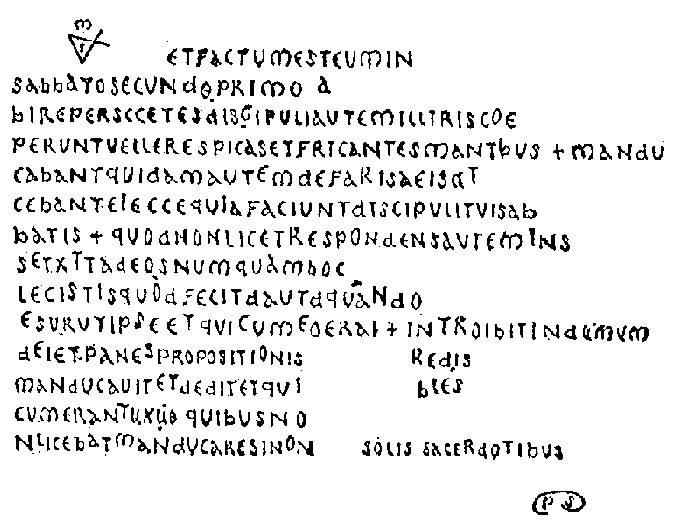
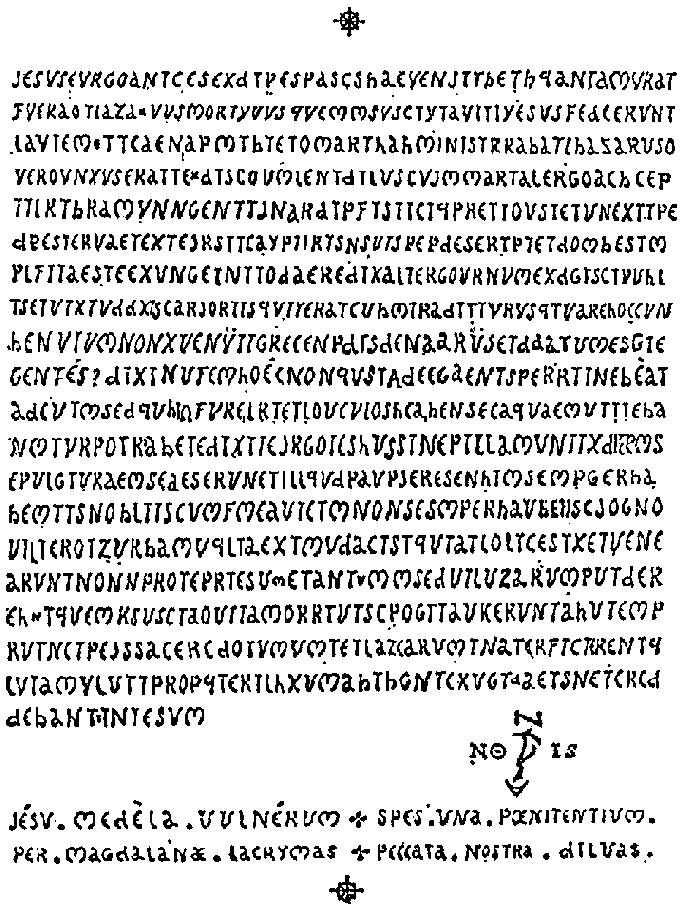
Quote: ERGÈRE PAS DE TENTATION QUE POUSSIN
TENIERS GARDENT LA CLEF PAX DCLXXXI
PAR LA CROIX ET CE CHEVAL DE DIEU
J'ACHÈVE CE DAEMON DE GARDIEN À MIDI
POMMES BLEUES
(in English)Quote: SHEPHERDESS NO TEMPTATION THAT POUSSIN
TENIERS HOLD THE KEY PEACE 681
BY THE CROSS AND THIS HORSE OF GOD
I COMPLETE (or I DESTROY) THIS DEMON GUARDIAN AT MIDDAY
BLUE APPLES.
© 2025 Created by Jonathan Barlow Gee.
Powered by
![]()
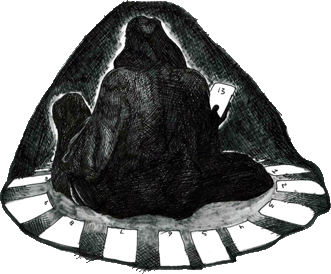
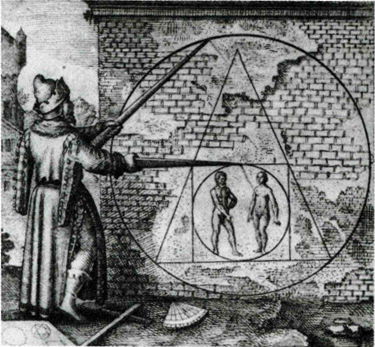
You need to be a member of the Pythagorean Order of Death to add comments!
Join the Pythagorean Order of Death